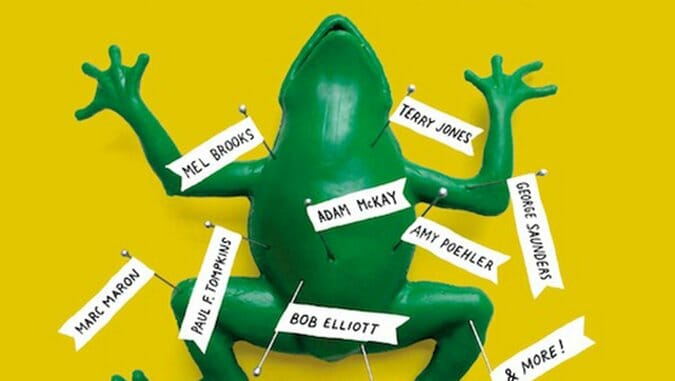Poking a Dead Frog by Mike Sacks
Conversations with Today’s Top Comedy Writers

The list of well-known war correspondents runs long. Those who bravely document our collective violent means—and put their own lives on the line—turn famous in their own right. Hemingway, Herr, Amanpour, et al.
Those who write about comedy? Not so much. Because comedy is not war. Comedy is just … comedy. Those who practice it have long been relegated, if lucky, to “court jester” status of society. And court jesters aren’t worth writing about.
Are they?
Of course, one might argue that if we shifted our priorities a little, if we paid more attention to what made us laugh—if we spent more time trying to make others laugh and less time trying to kill each other—a lot less people would die horrible deaths.
Just a theory.
So, okay, in that sense, comedy rules. The stuff that makes us laugh displays in us the most delightful and admirable characteristics of our humanity. Also, laughing just feels really good. We can all agree it’s one of the best three feelings in the world.
And sure, we know the Pattons and Napoleons and Joan of Arcs of comedy: C.K., Bruce, Silverman. But why don’t we know about those who write about them? Why aren’t comedy correspondents feted and living in Paris?
The truth is, not many people do write about comedy. Or if they do, they end up in the same position as most of us—failing to accurately comprehend, let alone crystallize, the magic of humor. (Confession: A school assignment once required this reviewer to explain what makes us laugh, and he conjured the idea of a feather locked inside us all, near the heart, tickling us when moved.)
All this is why we should all pay attention to Mike Sacks. If you need proof that the guy knows funny, understand the following: Sacks is one of the few people on this planet to actually get published by both perennially upstart humor site McSweeney’s Internet Tendency as well as The New Yorker’s “Shouts & Murmurs” (in the actual magazine, the Iron Curtain of publishing). In humor writing, this is like, say, a hole in one. There should be an award.
Sacks also offers help. When not writing funny pieces, or working his day job as a staff writer at Vanity Fair, he dedicates his spare time working as one of our preeminent comedy correspondents. It’s a good thing, too, because many would argue that we have reached a Golden Age of Comedy, what with the Internet and TV and movies and satellite radio, combined with all the terrible things happening around us. In a metaphor stretched much too far, the comedic are storming beaches, and Sacks rides with the first wave, notebook in hand.
-

-

-

-

-

-

-

-

-

-

-

-

-

-

-

-

-

-

-

-

-

-

-

-

-

-

-

-

-

-

-

-

-

-

-

-

-

-

-

-









































